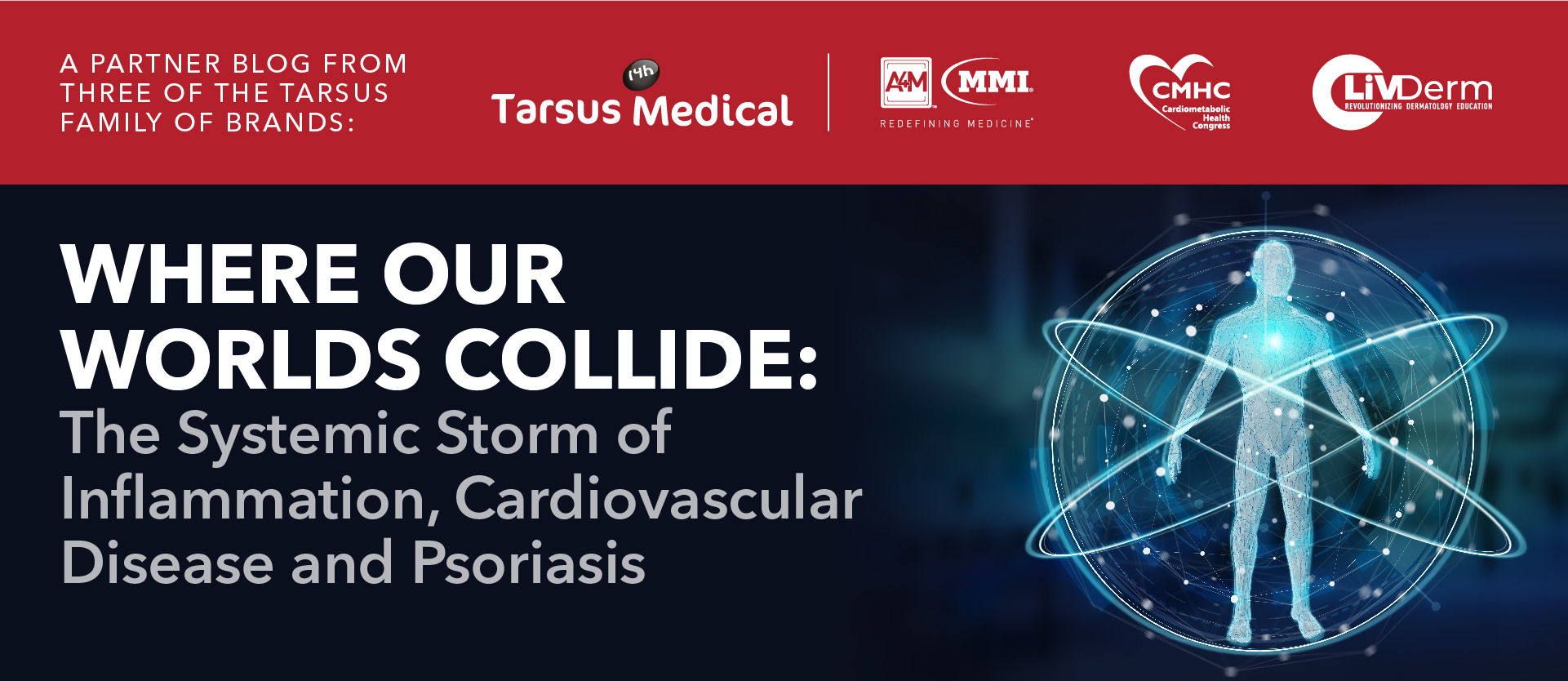This is a partner Blog from three of the Tarsus Family of Brands: American Academy of Anti-Aging Medicine (A4M), Cardiometabolic Health Congress (CMHC), and LiVDerm.
Introduction
A review published in May 2021 in the European Cardiology Review sought to elucidate the various potential factors, mechanisms, or processes linking cardiovascular disease (CVD) and psoriasis. Observational relationships between these two diseases include: an increased independent association between cardiovascular disease and severe psoriasis in younger patients; a higher mortality rate in patients with psoriasis with an overall five-year reduction in life expectancy; a parallel rise in psoriasis severity and CVD risk factors such as hypertension, diabetes, hyperlipidemia and nonalcoholic fatty liver disease; a higher rate of both CVD and psoriasis in geographical populations furthest from the equator; and the majority of deaths in patients with psoriasis being attributed to cardiovascular or cerebrovascular events. The authors of the review noted that severe psoriasis was more strongly linked to cardiovascular-related mortality than was mild or moderate psoriasis.
Different aspects of this relationship, such as genetic, environmental, and social risk factors, as well as pathogenic and pharmacological connections have been explored. One particularly compelling hypothesis is that systemic inflammation present in both psoriasis and CVD either leads to, or exacerbates, each disease. The evidence supporting this theory shows other disease states and risk factors, and an array of complex immune and non-immune inflammatory mediators present a plausible link. Pharmacotherapy also presents a potential association, especially with the advent of biological agents which directly act on inflammatory factors shared by the two diseases.
In this special partner blog, each Tarsus Medical brand will pose a possible explanation for the link between CVD and psoriasis and support its position with data and evidence from the body of literature in this area.
Psoriasis prevalence
Psoriasis is the number one cutaneous disease, affecting an estimated 8 million people in the U.S. This chronic inflammatory multisystemic skin condition primarily affects skin and joints, and is characterized by scaly skin lesions in the form of patches, plaques or pustules with episodes of relapse and remission. About 2% of the world population has some form of psoriatic disease, most presenting before 30 years old. There is evidence that geographical locations and ethnic backgrounds have higher rates of psoriasis – it has been observed that countries farther from the equator and Caucasian populations have a higher prevalence of the disease. This variation is thought to be related to various degrees of genetic and environmental factors.
CVD prevalence
Similarly, CVD is the number one cause of mortality for both men and women; heart disease, stroke, coronary heart disease and myocardial infarction are the most common causes of death, exacerbated by risk factors such as hypertension, high cholesterol, atherosclerosis, smoking, poor diet, sedentary lifestyle, alcohol consumption, and more. In the U.S. alone, more than 500 million people have some form or degree of CVD. Like psoriasis, some CVDs are also more common in these geographical locations farther from the equator and could be attributed to similar risk factors.
LiVDerm’s Takeaway
Both CVD and psoriasis are extremely common conditions that are also chronic and usually lifelong once they develop. The sheer incidence of both diseases in any given population means there will be overlap – this likely explains why many people with psoriasis also develop CVD at some point in their lives.
Evidence for shared pathophysiology in psoriasis and CVD raises the question of whether the cutaneous disease or its treatment is the factor that affects cardiovascular risk. The established pharmacotherapy used to treat psoriasis has a dual effect on patients’ cardiovascular risk profile. Limited data on new biologics and biosimilars for psoriasis treatment seem to show a positive effect on cardiovascular health, but more evidence is needed.
Methotrexate
Methotrexate, for instance, is one of the oldest systemic treatment agents and was thought to have new promises in reducing vascular diseases in patients with psoriasis, but the CIRT trial showed that low-dose methotrexate did not reduce adverse cardiovascular events in patients with established CVD. Elevated levels of TNF-α and soluble TNF-α receptors are found in the skin lesions of patients with severe psoriasis, which likewise present the development of atherosclerosis, deterioration of heart function, and remodeling of the vascular endothelium.
Cyclosporine
Despite being an effective treatment for psoriasis, cyclosporine has been strongly linked to worsening hypertension and an underlying factor in the development of chronic kidney disease. Cyclosporine also suppresses vasodilators such as prostacyclin and nitric oxide, which results in vasoconstriction, and sodium retention, ultimately worsening hypertension. Because of this, providers have been advised to only use ciclosporin for a short period of time with a plan to switch to another systemic agent once the psoriasis flare has been remedied.
Steroids
Steroids have shown effective results in the treatment of psoriasis but are also implicated in the development of new or worsening of CVD. They can potentially cause hypertension by various mechanisms, such as increased systemic vascular resistance, extracellular volume, cardiac contractility, sodium retention, hypokalemia and hypertension. Even some nonsteroidal anti-inflammatory drugs have similar effects as steroids: acitretin, a vitamin A analogue used to treat psoriasis, increases serum triglycerides and LDL cholesterol, and decreases the blood HDL levels.
CMHC’s Takeaway
Traditional psoriasis pharmacotherapy such as methotrexate, cyclosporine, acitretin and steroids have been shown to have negative impacts on cardiovascular health. This may explain why patients with psoriasis often develop CVD later in life after being exposed to these agents. However, new studies have found that novel biologic and biosimilar drugs more recently approved for psoriasis may actually reduce the risk of CVD, so providers should be aware of the emerging literature on these drugs, especially for their patients with psoriasis with existing CVD or those at high risk for developing CVD.
Comorbidity is a common feature of immune-mediated inflammatory diseases; in this case, the association between psoriasis and numerous comorbid conditions, including cardiovascular diseases, is well-documented. Systemic inflammation in psoriasis yields hyperhomocysteinemia, elevated highly sensitive-C-reactive protein, platelet hyperactivity, and elevated inflammatory cytokines, all of which are suspected to contribute to the pathogenesis of metabolic syndrome, obesity, atherosclerosis, and myocardial infarction. Chronic systemic inflammation can trigger atherosclerosis through insulin resistance and endothelial dysfunction, which are the probable pathogenetic link. This biological explanation suggests that psoriasis and CVD are connected through common immunological and inflammatory pathways.
Obesity
Obesity is thought to be a key contributor to the development of both psoriasis and CVD due to the incidence and prevalence of the condition in psoriasis patients, and its independent association with CVD. Obesity is also a factor in metabolic syndrome, which induces systemic inflammation caused by abdominal obesity, impaired glucose tolerance, hypertriglyceridemia, hypertension, and low HDL cholesterol. The visceral adipose tissue present in patients with obesity triggers the release of adipokines, which contribute to insulin resistance, endothelial cell damage, and ultimately the formation of atherosclerotic plaques found in CVD.
Plaque Formation
Altered endothelial function and the subsequent recruitment of leukocytes for the development of lesions are shared early steps in the process of plaque formation in both atherosclerosis and psoriasis. To date, multiple shared pathogenetic mechanisms have been implicated in psoriatic and atherosclerotic plaque formation; however, these similarities do not explain why psoriasis can also be considered an independent cardiovascular risk factor.
Oxidative Stress
Oxidative stress is a key element in the development of CVD in patients who already have psoriasis. This phenomenon participates in the process of atherosclerosis by the effect of oxygen metabolites, which modify oxidatively LDL cholesterol and the antioxidant capacity is consequently overwhelmed. The resulting oxidative stress leads to oxidative damage to the lipids and proteins. This discrepancy between oxidant and antioxidant factors is involved in the pathogenesis of accelerated atherosclerosis in psoriasis patients as evidenced in a 2017 study.
Platelets
Immune cells that trigger and regulate immune and inflammatory processes and their dysfunction are deeply involved in the pathogenesis of psoriasis. A study demonstrated that platelets taken from patients with psoriasis showed a significantly increased percentage of platelet aggregation and could stimulate an inflammatory environment by releasing biologically active molecules in skin disorders such as psoriasis.
A4M’s Takeaway
As the biological processes and relationships above indicate, psoriasis cannot be regarded as an isolated cutaneous inflammation. Instead, it represents a chronic systemic inflammatory disease that shares inflammatory and immunological pathways with numerous health conditions leading to the high risk and incidence of comorbidity. The effective management and treatment of each individual disease state, as well as comorbid presentations, require an integrated, multispecialty approach.
Conclusions
Although a causal relationship between the development of CVD in patients with psoriasis is still under investigation, providers must be cognizant of signs of CVD in patients with psoriasis and devise a plan to encourage multidisciplinary management between specialties when indicated. Until more long-term prospective studies of patients with psoriasis can identify those at the greatest risk for CVD comorbidities, dermatologists, cardiologists, and general practitioners should implement preventive and early therapeutic measures to reduce the likelihood of CVD events such as acute myocardial infarction and stroke in patients with psoriasis.
- https://www.ecrjournal.com/articles/association-between-psoriasis-and-cardiovascular-diseases
- https://www.psoriasis.org/psoriasis-statistics/
- https://www.ahajournals.org/doi/10.1161/CIRCIMAGING.118.007849?cookieSet=1#:~:text=Systemic%20inflammation%20has%20been%20put%20forward%20as%20a,factor-%CE%B1%20antagonists%2C%20would%20result%20in%20decreased%20cardiovascular%20events
- https://www.acc.org/about-acc/press-releases/2020/12/09/18/30/cvd-burden-and-deaths-rising-around-the-world
- https://www.ncbi.nlm.nih.gov/pmc/articles/PMC5898839/
- https://www.ncbi.nlm.nih.gov/pmc/articles/PMC5895645/#:~:text=regimen%20(134).-,Prevention,of%20patients%20with%20severe%20psoriasis
- https://www.ncbi.nlm.nih.gov/pmc/articles/PMC5926341/



















